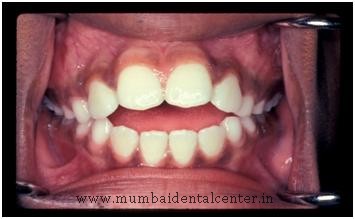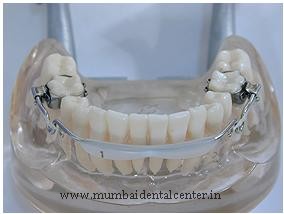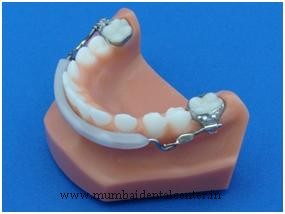A habit is a pattern of behaviour that happens regularly until your child does it almost without thinking. Oral habits include:
- Thumb Sucking
- Lip Sucking, Lip Biting
- Tongue Thrusting
These habits, when excessive or are continued past appropriate developmental necessity, can lead to poor dental health, be socially stigmatizing, and inhibit the development of speech clarity.
- Thumb Sucking
Thumbsucking is a common habit of preschool children, if continued it can hard teeth and looks of the kid. The activity is normal for infants and toddlers, but should decrease by age 3 or 4 and stop by age five. Thumb sucking that persists beyond the eruption of permanent teeth can cause improper growth of the mouth and misalignment of the teeth.
The more time a child sucks his thumb and the greater the sucking pressure, the more harm done to teeth and jaws. Day and night forceful thumbsucking makes front teeth move, and can even reshape the jaw bone. Upper front teeth flare out and tip upward while lower front teeth move inward.

The simplest way to stop the habit is to first counsel the patient. Depending on the willingness of the child to stop the habit, three different approaches to treatment have been advocated.
They are:
- Reminder Therapy: This is appropriate for those who want to stop the habit but need some help to stop completely.An adhesive bandage taped to the offending finger can serve as a constant reminder not to place the finger/digit in the mouth. The “reminder” must be neutral and not perceived as any form of punishment.
- Reward Therapy: A contract is agreed upon between the child and parent or between the child and dentist. The contract simply states that the child will discontinue the habit for a specified period of time and in return he/she will receive a reward if the requirements of the contract are met. The more involvement the child can take in the project, the more likely the project will succeed.
- Appliance Therapy: The appliance's technical name is a "fixed palatal crib," and is a type of brace that sits full-time on the upper teeth and the roof of the mouth. The crib consists of semicircular stainless steel wires connected to supporting steel bands or rings. The half-circle of wires fits behind the child's upper front teeth, barely visible in normal view.
Crib wires prevent the thumb or finger from touching the gums behind the front teeth and on the palate (roof of the mouth), turning a pleasant experience into an unpleasant one. Deriving no satisfaction from the activity, the child has no incentive to continue. The bands are fastened to the baby upper second molars.

- Lip Sucking
The most common presentation of lip sucking is the lower lip tucked behind the Upper incisors/ front teeth. This force and pressure applied to suck on the lower lip causes the inward tilting of the lower teeth and a restriction in the development of the lower jaw, also a proclination of the Upper front teeth making them look larger.
Lip Bumper: A lip bumper is a dental appliance used in the orthodontic treatment of children. It's basically a wire that is partially coated in plastic. The wire is hooked on to two molars at either end and lines the front side of the lower teeth. It allows the tongue to gently press against the lower teeth, thereby creating more space for them. At the same time, it keeps the cheeks and lower lip from exerting too much pressure on the teeth which can lead to crowding. The appliance also pushes the patient's lower molars back to make room for permanent teeth.


- Tongue thrust
Tongue thrusting, simply defined, is the habit of placing the tongue in the wrong position during swallowing, either too far forward or to the sides. It is estimated that every 24 hours you swallow a total of 1,200 to 2,000 times, with about four pounds of pressure per swallow. This constant pressure of the tongue will force the teeth and arches out of alignment. Besides the pressure exerted while swallowing, nervous thrusting also pushes the tongue against the teeth while it is at rest. This is an involuntary, subconscious habit that is difficult to correct.
Suspected causes of thumb sucking
- Thumbsucking
- Some artificial nipples used for feeding infants
- Mouth breathing which can cause the tongue’s posture to be very low in the mouth. Nasal congestion, allergies, or obstructions may contribute to this.
- Difficulty swallowing which can be a result of adenoids, frequent sore throats or tonsils
- An exceptionally large tongue
- The angle of the jaw line or other hereditary factors within a family
- Muscular, neurological, or other physiological abnormalities
- Being” tongue tied” – a short lingual frenum
Treatment for Tongue thrust: Generally, the tongue thrust swallowing pattern may be handled in two ways:
- Correction by MyoFunctional Therapy or Tongue Therapy, which is an exercise technique that re-educates the tongue muscles. It is similar to “physical therapy” for the tongue, which is taught by a trained therapist. The length of therapy is based upon the patient’s cooperation and dedication. Therapy has proven to give the highest percentage of favorable results.
- An appliance that is placed in the mouth by the dentist or orthodontist, which is generally not very successful. It is simply a punishment for the tongue instead of retraining.





